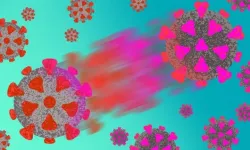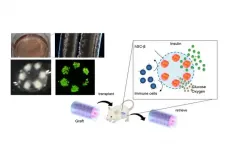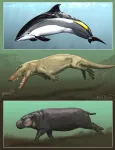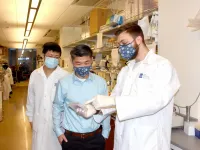(Press-News.org) A highly contagious SARS-CoV-2 variant was unknowingly spreading for months in the United States by October 2020, according to a new study from researchers with The University of Texas at Austin COVID-19 Modeling Consortium. Scientists first discovered it in early December in the United Kingdom, where the highly contagious and more lethal variant is thought to have originated. The journal Emerging Infectious Diseases, which has published an early-release version of the study, provides evidence that the coronavirus variant B117 (501Y) had spread across the globe undetected for months when scientists discovered it.
"By the time we learned about the U.K. variant in December, it was already silently spreading across the globe," said Lauren Ancel Meyers, the director of the COVID-19 Modeling Consortium at The University of Texas at Austin and a professor of integrative biology. "We estimate that the B117 variant probably arrived in the U.S. by October of 2020, two months before we knew it existed."
Analyzing data from 15 countries, researchers estimated the chance that travelers from the U.K. introduced the variant into 15 countries between Sept. 22 and Dec. 7, 2020. They found that the virus variant had almost certainly arrived in all 15 countries by mid-November. In the U.S., the variant probably had arrived by mid-October.
"This study highlights the importance of laboratory surveillance," Meyers said. "Rapid and extensive sequencing of virus samples is critical for early detection and tracking of new variants of concern."
In conjunction with the paper's publication, consortium members developed a new tool that decision-makers anywhere in the United States can use in planning for genetic sequencing that helps to detect the presence of variants. To help the U.S. expand national surveillance of variants, the new online calculator indicates the number of virus samples that must be sequenced in order to detect new variants when they first emerge. For example, if the goal is to detect an emerging variant by the time it is causing 1 out of every 1,000 new COVID-19 infections, approximately 3,000 SARS-CoV-2 positive specimens per week need to be sequenced.
"Health officials are looking for better ways to manage the unpredictability of this virus and future variants," said Spencer Woody, a postdoctoral fellow at the UT COVID-19 Modeling Consortium. "Our new calculator determines how many positive SARS-CoV-2 specimens must be sequenced to ensure that new threats are identified as soon as they start spreading."
He explained that the calculator has a second feature. "It also helps labs figure out how quickly they will detect new variants, given their current sequencing capacity."
"We created this tool to support federal, state and local health officials in building credible early warning systems for this and future pandemic threats," Meyers said.
INFORMATION:
More detailed information on the calculator is here.
In addition to Meyers, authors of the Emerging Infectious Disease paper are Zhanwei Du, Bingyi Yang, Sheikh Taslim Ali, Tim K. Tsang, Songwei Shan, Peng Wu, Eric H.Y. Lau and Benjamin J. Cowling of the WHO Collaborating Centre for Infectious Disease Epidemiology and Control in Hong Kong and Lin Wang of the University of Cambridge.
The research was funded by Hong Kong's Health and Medical Research Fund, the National Institutes of Health and the Centers for Disease Control and Prevention.
Meyers holds the Denton A. Cooley Centennial Professorship at The University of Texas at Austin.
A possible explanation for why many cancer drugs that kill tumor cells in mouse models won't work in human trials has been found by researchers with The University of Texas Health Science Center at Houston (UTHealth) School of Biomedical Informatics and McGovern Medical School.
The research was published today in Nature Communications.
In the study, investigators reported the extensive presence of mouse viruses in patient-derived xenografts (PDX). PDX models are developed by implanting human tumor tissues in immune-deficient mice, and are commonly ...
Boulder, Colo., USA: The Geological Society of America regularly publishes
articles online ahead of print. For March, GSA Bulletin topics
include multiple articles about the dynamics of China and Tibet; the ups
and downs of the Missouri River; the Los Rastros Formation, Argentina; the
Olympic Mountains of Washington State; methane seep deposits; meandering
rivers; and the northwest Hawaiian Ridge. You can find these articles at
https://bulletin.geoscienceworld.org/content/early/recent
.
Transition from a passive to active continental ...
We've all heard the adage, "If at first you don't succeed, try, try again," but new research from Carnegie Mellon University and the University of Pittsburgh finds that it isn't all about repetition. Rather, internal states like engagement can also have an impact on learning.
The collaborative research, published in Nature Neuroscience, examined how changes in internal states, such as arousal, attention, motivation, and engagement can affect the learning process using brain-computer interface (BCI) technology. Findings suggest that changes in internal states can systematically influence how behavior improves with learning, thus paving the way ...
A study reported in the journal Current Biology on April 1 has both good news and bad news for the future of African elephants. While about 18 million square kilometers of Africa--an area bigger than the whole of Russia--still has suitable habitat for elephants, the actual range of African elephants has shrunk to just 17%of what it could be due to human pressure and the killing of elephants for ivory.
"We looked at every square kilometer of the continent," says lead author Jake Wall of the Mara Elephant Project in Kenya. "We found that 62% of those 29.2 million ...
Tokyo, Japan - Type I Diabetes Mellitus (T1D) is an autoimmune disorder leading to permanent loss of insulin-producing beta-cells in the pancreas. In a new study, researchers from The University of Tokyo developed a novel device for the long-term transplantation of iPSC-derived human pancreatic beta-cells.
T1D develops when autoimmune antibodies destroy pancreatic beta-cells that are responsible for the production of insulin. Insulin regulates blood glucose levels, and in the absence of it high levels of blood glucose slowly damage the kidneys, eyes and peripheral ...
A new study shows that the similarly smooth, nearly hairless skin of whales and hippopotamuses evolved independently. The work suggests that their last common ancestor was likely a land-dwelling mammal, uprooting current thinking that the skin came fine-tuned for life in the water from a shared amphibious ancestor. The study is published today in the journal Current Biology and was led by researchers at the American Museum of Natural History; University of California, Irvine; University of California, Riverside; Max Planck Institute of Molecular Cell Biology and Genetics; and the LOEWE-Centre for Translational Biodiversity Genomics (Germany).
"How mammals left terra firma and became fully aquatic is one of the most fascinating evolutionary ...
PHILADELPHIA -- (April 1, 2021 -- Scientists at The Wistar Institute identified a new mechanism of transcriptional control of cellular senescence that drives the release of inflammatory molecules that influence tumor development through altering the surrounding microenvironment. The study, published in Nature Cell Biology, reports that methyltransferase-like 3 (METTL3) and 14 (METTL14) proteins moonlight as transcriptional regulators that allow for establishment of the senescence-associated secretory phenotype (SASP).
Cellular senescence is a stable state of growth arrest in which cells stop dividing but remain viable and produce an array of inflammatory and growth-promoting molecules collectively defined as SASP. These molecules account ...
The University of Maryland (UMD) has collaborated with Cornell University and Stanford University to quantify the man-made effects of climate change on global agricultural productivity growth for the first time. In a new study published in Nature Climate Change, researchers developed a robust model of weather effects on productivity, looking at productivity in both the presence and absence of climate change. Results indicate a 21% reduction in global agricultural productivity since 1961, which according to researchers is equivalent to completely losing the last 7 years ...
ITHACA, N.Y. - Despite important agricultural advancements to feed the world in the last 60 years, a Cornell-led study shows that global farming productivity is 21% lower than it could have been without climate change. This is the equivalent of losing about seven years of farm productivity increases since the 1960s.
The future potential impacts of climate change on global crop production has been quantified in many scientific reports, but the historic influence of anthropogenic climate change on the agricultural sector had yet to be modeled.
Now, a new study provides these insights: "Anthropogenic Climate Change Has Slowed Global Agricultural Productivity ...
Many wildlife species are threatened by shrinking habitat. But according to new research, the potential range of African elephants could be more than five times larger than its current extent.
Due to 2,000 years of human pressure, African elephants have suffered dramatic population declines, and their range has shrunk to just 17% of what it could be, say researchers who led the new study, in Current Biology.
The dramatic reduction in range is due to the killing of elephants for their ivory and the encroachment of humans into elephant habitat. Evidence for elephants being ...






